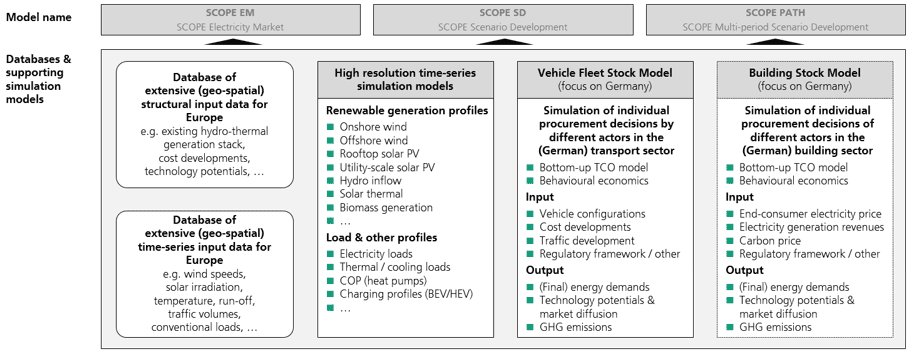In general, Fraunhofer IEE’s energy system models must be differentiated in their application purpose between the determination of investment decisions and detailed deployment planning.
The SCOPE Path and SCOPE SD model variants enable the determination of installed capacities in future cost-optimized energy sector-spanning scenarios for Europe. They differ in the closed path optimization with lower temporal and spatial resolution and the detailed determination of individual scenario years.
The SCOPE EM electricity market model enables detailed analyses of pricing on the European electricity markets and grid node-specific analyses in the German transmission grid on the basis of these determined capacities.

The geographical scope of Europe is the EU27 including Great Britain, Norway, Switzerland and excluding Malta and Cyprus.

Within Germany, possible divisions into market areas (zones) can be taken into account. The regional resolution of the market results in Germany then refers downstream to individual grid nodes.

Energy supply
The SCOPE Path and SCOPE SD energy system model makes expansion decisions in the areas of electricity supply, district heating supply and industrial process heat supply (hot water and steam). Optionally, the expansion decisions in the building heating supply and road transport can also be optimized. This is an annual plan with perfect foresight. A linear optimization problem is set up, which is solved by the commercial solver Gurobi.

The SCOPE-EM electricity market model optimizes the use of systems to meet electricity demand, reserve balancing power and cover demand for heat and transport. In order to carry out modeling based on the processes on the electricity market, the hours of the year are run through using rolling planning. This means that a period of 48 hours, for example, is optimized, which is then shifted forward 24 hours for the next optimization step. Storage levels as well as shutdown and start-up times of power plants are transferred to the next optimization step. A mixed integer linear optimization problem is set up, which is solved by the commercial solver Gurobi. The SCOPE-EM model itself is implemented in Matlab.
The basis for this is high-resolution spatial data and time series. In the area of renewable electricity generation potential and demand, this is covered at Fraunhofer IEE by the energyANTS simulation model.
Socio-economic trends and macroeconomics
Depending on scenarios, economic boundary conditions can be specified indirectly via exogenous demand developments.
Energy Demand
The input data for the energy system and electricity market models are shown in the following diagram.

Industry
Demand trends and potential targets are taken exogenously from bottom-up simulations and published studies. Industrial process heat in the area of hot water and steam is optimally covered endogenously. Furnaces and material use are specified.
Buildings
Optionally, demand trends and potential targets can be taken from bottom-up simulations and published studies or be determined for Germany using the AgentHomeID building stock model.
Transport
Alternatively, demand trends and potential targets can be taken from bottom-up simulations and published studies or determined for Germany using the AgentCarID vehicle stock model.
Flexibility (storage, DSM, grids)
Flexibilities in the electricity, heating and transport sectors are differentiated between seasonal and short-term and mapped using validated aggregation models.
Policy instruments and measures
Political boundary conditions can be evaluated by means of potential limits, electricity cost components, financing costs, etc. in terms of their impact on investment decisions and plant deployment in the electricity market.
Links and references
- https://ariadneprojekt.de/media/2024/01/Ariadne-Analyse_Angebotszonen_Januar2024.pdf
- https://maps.iee.fraunhofer.de/trafo-atlas/
- Fraunhofer IEE: Global PtX Atlas (2021). https://maps.iee.fraunhofer.de/ptx-atlas/
- Pfennig, M., Böttger, D., Häckner, B., Geiger, D., Zink, C., Bisevic, A., Jansen, L.: Global GIS-based potential analysis and cost assessment of Power-to-X fuels in 2050 (2022). https://doi.org/10.48550/arXiv.2208.14887
- Schmitz, R., Naversen, C., Härtel, P.: Case study result data set for Energy Systems (submitted) article: Influence of hydrogen import prices on hydropower systems in climate-neutral Europe. Zenodo (2023). https://doi.org/10.5281/zenodo.7692180
- https://www.iee.fraunhofer.de/de/projekte/suche/2022/hydroconnect.html
- https://www.iee.fraunhofer.de/de/presse-infothek/Presse-Medien/2022/schnelle-abschaetzung-zukuenftiger-stromtransportbedarfe.html / https://www.oeko.de/fileadmin/oekodoc/UPTAKE_Endbericht.pdf
- Härtel, P., Korpås, M.: Modelling heat pump systems in low-carbon energy systems with significant cross-sectoral integration, IEEE Transactions on Power Systems, Volume 93, 105051, 2020. doi: 10.1109/TPWRS.2020.3023474.
- Härtel, P., Korpås, M.: Demystifying market clearing and price setting effects in low-carbon energy systems, Energy Economics, Volume 93, 105051, 2021.doi: 10.1016/j.eneco.2020.105051.
- Böttger, D., Härtel, P.: On wholesale electricity prices and market values in a carbon-neutral energy system, Energy Economics, Volume 106, 105709, 2022. doi: 10.1016/j.eneco.2021.105709.
- Böttger, D., Jentsch, M., Trost, T., Gerhardt, N., von Bonin, M., Eschmann, J.: Cost-Optimal Market Share of Electric Mobility Within the Energy System in a Decarbonisation Scenario. 2018 15th International Conference on the European Energy Market (EEM), 1–5 (2018). https://doi.org/10.1109/EEM.2018.8469846
- Härtel, P., Ghosh, D.: Modelling heat pump systems in low-carbon energy systems with significant cross-sectoral integration. IEEE Transactions on Power Systems 37(4), 3259–3273 (2020). https://doi.org/10.1109/TPWRS.2020.3023474
- Frischmuth, F., Härtel, P.: Hydrogen sourcing strategies and cross-sectoral flexibility trade-offs in net-neutral energy scenarios for Europe. Energy 238, 121598 (2022). https://doi.org/10.1016/j.energy.2021.121598 ● Härtel, P., Korpås, M.: Aggregation Methods for Modelling Hydropower and Its Implications for a Highly Decarbonised Energy System in Europe.Energies 10(11), 1841 (2017). https://doi.org/10.3390/en10111841


